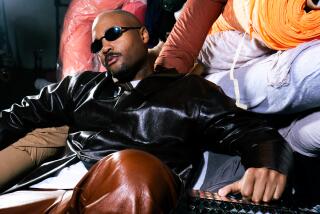Fashion statement -- or sheer spectacle?
- Share via
It takes a special kind of man to wear a monocle. You need to be a 19th century deep thinker, like Alfred, Lord Tennyson or Karl Marx, or maybe a jackbooted Aryan type, like Col. Klink on “Hogan’s Heroes.” It works too if you’re a jaunty cartoon character with a top hat, like the Penguin from “Batman” or Mr. Peanut from the Planters label.
Now we can add a new category to the accessories list of winking devotees: 21st century gossipmongers of Manhattan.
Last Saturday, on the front page of the New York Times (above the fold, no less), there was a color photograph of an honest-to-goodness monocle-wearing man. Well, maybe honesty and goodness had nothing to do with it; the guy in question was one Jared Paul Stern, a sometime scribe for the New York Post now under investigation after a California tycoon alleged that the writer had tried to extort money from him.
Party photos have made it clear that gossip writer Stern is one of those anachronistic peacocks who wear fedoras, waistcoats, spats, ascots or the other eccentric fashion flourishes that, when worn to a shipyard or a pool hall, scream out: “Punch me hard in the face.” But when Stern scrunched his socket on that monocle (the photo that captured the moment was snapped in 2001), he took his personal dandyism to a whole new level. You can argue that a fedora channels the spirit of Bogart and Spillane, but a monocle is just pure Charlie McCarthy. And Charlie McCarthy was, well, a dummy. Sorry. But he was.
History tells us the monocle was devised in the 19th century by the British, who also invented mutton-chop sideburns and the term “harrumph,” and all three go together quite nicely. The monocle, like a pocket watch, dangles from a chain or cord and is often accompanied by a fancy vest with pockets. That’s why there’s still a whiff of upper-crust pretension to the loop accessory; if you have an eye for affectation, the monocle will put you in the same circles as the rich tycoon from the Monopoly box or Eustace Tilley, the veddy proper cartoon mascot for the New Yorker. The rich of London in the 1800s often had plaster casts made of their faces so they could get a comfortable and snug monocle fit -- anyone in the lower class who naively bought the over-the-counter models that became available paid for their overreaching with a sore face.
In the early decades of American film, especially in comedy reels, the monocle was shorthand for stuffy aristocrat. You just knew the guy with the eye loop was going to take a pie from Moe or Curly.
But there is also a different, less-foppish species of one-eyed jacks. There’s the dictator monocle, popular with Luftwaffe brass and the alpha males of old Hollywood’s soundstages. The reason is best summed up in a kooky 1961 article from a magazine called Carnival Escapade. (We found it lovingly reprinted on a website called Java’s Bachelor Pad, which celebrates Tiki art, pinup girls, martinis and other vital districts of pop culture.) The article breathlessly celebrates the monocle as both a chick-magnet and prop for tough-guy messaging: “By its very insertion between cheekbone and brow, the monocle gives you a new interesting face. The keystone of the new look is the sneer, due less to a state of mind than a muscle contraction necessary to screw, so to speak, the monocle in the eye socket. The social value of the sneer? Incalculable.”
That’s why in World War I the monocle became a fashion craze among German officers, just as aviator glasses would later be the Right Stuff for American flyboys and reflective sunglasses became de rigueur for scary cops in Southern states. Erich von Stroheim wore the monocle memorably in one of the most acclaimed war films ever, Jean Renoir’s “Grand Illusion” in 1937, and that set the stage for Berlin-saluting baddies on film and television for decades. Werner Klemperer’s Col. Klink on “Hogan’s Heroes,” for instance, was clearly a feckless student of Von Stroheim’s true monocle menace.
There have been others with their eye on monocle revival, even if they went about it differently. The character Mad-Eye Moody, for instance, had a quasi-monocle in “Harry Potter and the Goblet of Fire,” but, on closer inspection, it turned out it was really more like a gross little holding tank for his eye than a true eyesight aid. In urban culture, the late Lisa “Left Eye” Lopes memorably wore an unopened condom package just like it was a monocle, but the less said about that the better.
Really, the only monocle men of the moment seem to be Stern (who has made, ahem, a spectacle of himself with the unfolding scandal but could not be reached for comment for this story), and Mr. Peanut, that eternally smiling nut who, we are proud to tell you, celebrates a salty 90th anniversary this year. Even with that grand accomplishment, it’s hard to see a big future for the monocle. It hurts your face, and, if it’s a prescription lens, it can give you a bad headache. But maybe there is a different way to look at it; as a certain sentient and stylish peanut might say, “In the land of the blind, the one-eyed man is king.”






